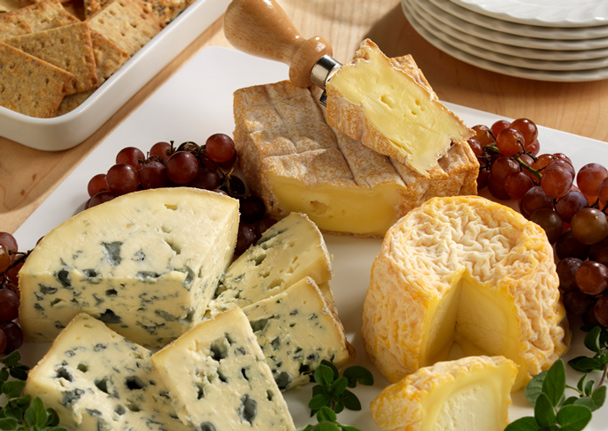We at Gourmet Live couldn't be more thrilled about the current craze for cheese. Artisanal cheese making thrives both here in the United States and abroad, cheesemongers have multiplied in our foodier locales, and restaurants both haute and humble are presenting cheese courses that leave the stodgy trolleys of old way behind. And so, we've decided to indulge ourselves with this plan for a party that spotlights a sublime selection of cheeses, along with accompaniments such as crusty loaves, fruit and nuts, and generous lashings of wine.
One advantage to this method of entertaining is its versatility: You can make your buffet as simple or as elaborate as your imagination, your cheese shop, and your wallet will allow. Part of the fun (aside from the shopping, of course) is the planning. Do you want to showcase the products of a particular country—regional classics of Italy, for instance, or hand-crafted cheeses of the United States—or would you rather home in on a specific type such as Cheddars or blues, or perhaps the kind of milk used (cow's, sheep's, goat's)?
For our admittedly extravagant offering, we decided to put together an eclectic assortment of cheese types and textures. You can mix and match them to compose a platter full of variety, or try serving the cheeses in "flights," or one group at a time—an enlightening way to compare and contrast different examples of the same kind of cheese. In that case, it's best to start with the lighter chèvres, then progress through the soft, creamy, cheeses and the more piquant hard cheeses, and end with the noble blues. (As when tasting wines, if you begin with more powerful flavors, your palate won't be able to appreciate the subtler ones.)
Accompaniments: Cheese of such caliber as those we've chosen deserve the very best breads you can find—a crusty baguette, an honest multigrain, a tangy sourdough, a walnut-studded whole-wheat. We've also lavished the table with the most beautiful grapes we could find; or try rich, sweet dates or walnuts.
Sources: The recommended cheeses can be found at many cheese stores, specialty foods shops, or online.
Storage and serving tips: Chill cheese, wrapped loosely in wax paper—it needs to "breathe" in order to further develop—and then in foil, in the bottom of the refrigerator. Cheese should never be frozen. Bring cheese to room temperature before serving; if served too cool, much of the flavor will be lost and the texture will be off. While it stands, leave it wrapped so that any cut surfaces don't dry out.
A note on the wines: When matching cheeses and wines, white wine, dry Sherry, and a sweet wine such as Sauternes or Port often prove the perfect complement, preferable to red wine in many cases. Because cheese has the effect of softening the tannic character of red wine, a mellow red can taste flabby and dull with a creamy cheese. And many pungent cheeses are simply too strong for reds. They may be better accompanied by a spirit such as Calvados or Marc de Bourgogne.
For the light, tangy goat cheeses, the very best match is a crisp, fresh Sancerre from the Loire Valley. Sauvignon blanc is grown in many regions of the world, but nowhere does it have the zip or the special mineral quality it has when grown in the chalky soil of Sancerre.
Soft, creamy cheeses have a certain unctuous quality that calls for full-bodied, intense whites or lively, fruity reds. For the white, Pinot Gris and Tokay d' Alsace are ideal with Alsatian Muenster. Both have plenty of flesh and spice to counter and stand up to the buttery texture of soft cheeses. A good red choice would be a cru Beaujolais or Morgon with sufficient structure and ripe, juicy fruit so as not to be muted by the creaminess of the cheese.
The hard cheeses demand red wine. The cru Beaujolais would be fine, but perhaps better suited would be a bigger, more substantial red such as a Cornas with layered, lush fruit as well as great balance and class.
One of the culinary world's great taste sensations is the pairing of a Sauternes with a blue-veined cheese. It inspires the same charge one gets when detecting a touch of salt in a sweet cookie. The acidity and sweetness in Sauternes provide a comparable tension and energy when matches with a salty, creamy cheese. Fortified wines such as Port are also a classic accompaniment to blue cheeses.



 Pinterest
Pinterest


